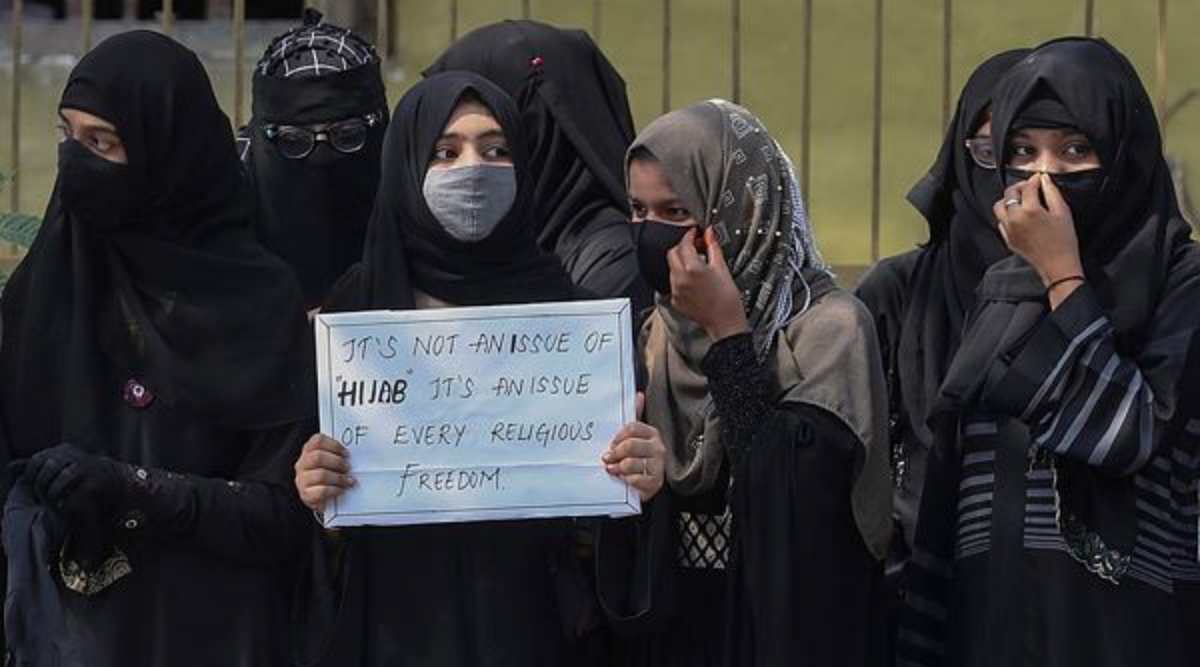February 24, 2022 4:45:47 am
 Muslim women’s voices are infantilised, dismissed, and forced to choose between false binaries such as education or hijab, Indianness or Muslimness. (Express Photo)
Muslim women’s voices are infantilised, dismissed, and forced to choose between false binaries such as education or hijab, Indianness or Muslimness. (Express Photo) Written by: Sania Mariam
The ongoing row over wearing the hijab in Karnataka’s classrooms has reignited age-old debates around veils, patriarchy and the status of Muslim women. However, among the cacophony of familiar arguments and counter-arguments, an essential voice seems to be missing: That of Muslim women, especially young women, who have chosen to pursue education as well as their faith.
The singular narrative of Muslim women as secluded, brainwashed victims of perceived male oppression, peddled globally by imperialist powers, has also found favour with the majoritarian forces at home. Often, this narrative is peddled by various factions of the society to “liberate” the Muslim women from the clutches of the Muslim man, the quintessential “mullah”. It is easy to believe this singular story given its prevalence in the visual and literary representations of Muslims worldwide. The sheer number of movies, pulp fiction, and television debates based on this theme fixes the discourse with which Muslims should engage. This obsession with Muslim women’s plight continues to authorise and legitimise a moral crusade of “saving” Muslim women.
The heart-breaking images of Muslim teachers and students being made to take off their headscarves and burqas at the school gates in Karnataka hark back to the well-choreographed ceremonies arranged by the French colonial rulers to publicly unveil Muslim women in Algeria. America’s “war on terror” was justified by the aim of “saving” Afghan Muslim women through carpet-bombing Afghanistan. The anti-triple talaq legislation criminalised Muslim men to “save” Indian Muslim women. In this process, Muslim spaces get invaded, their practices criminalised, and Muslim women’s voices appropriated.
The spokespersons on the hijab row in the media such as Arif Mohammad Khan, Taslima Nasreen, Javed Anand and Javed Akhtar do not represent the modern, hijab-wearing Muslim woman. The lines between the right-winger, liberals, and progressives are blurred by their mutual pity for Muslim women. These voices claim to think for us and define the choices we ought to make, just as colonisers do. Muslim women prioritising their commitments to the values of their faith is not seen as a valid choice they should be making. The hijabi Muslim women, on the streets to defend their choice of clothing, remain persistently unheard by those preaching the virtues of freedom. There is an obsession with defining Muslim women’s rights by values of choice and freedom alone, which are projected to not exist within the community.
Such a framing of Muslim women’s oppression limits other concerns that plague them. Whether it is the online “auction” of Muslim women’s bodies or the fetishisation of Kashmiri Muslim women after the removal of Article 370, there is a growing trend of targeting Muslim women. Perhaps, the worst of such sexualisation occurs during communal riots, when Muslim women’s bodies are hunted as a prized possession. This discourse on liberating Indian Muslim women is silent on freeing them from these everyday acts of violence, and Islamophobia.
The dynamics that shape Muslim women’s lives in India are varied and need to be understood before reducing them to a single narrative. The political and historical explanations behind women’s oppression are often ignored in lieu of religious and cultural explanations alone, with little or no nuance. Many of the sufferings of women in general, and Muslim women in particular, can be attributed to reasons such as poverty, ill-health, low levels of education, limited access to public amenities, and political violence inflicted on them and their families. But concerns about being denied access to education and jobs are not acceptable, unless religious reasons are attached. The uproar over the hijab row shows the selective sensationalisation of their concerns.
Muslim women are not mute spectators in the Indian political discourse. The resilience of the women of Shaheen Bagh, many of them in hijab and burqa, should not be forgotten. These women have shaped the resistance in preserving the changing nature of increasingly majoritarian India. In this process, they have also paid a heavy price, with their brothers, husbands, and fathers being picked up, abused, and detained in Indian jails. The gatekeepers of civil societies need to acknowledge their contribution to defending Indian democracy when they are the most vulnerable. Any genuine engagement to address gendered forms of discrimination and violence in any community cannot be superimposed by an authoritarian conception and fixation with freedom alone.
Muslim women’s voices are infantilised, dismissed, and forced to choose between false binaries such as education or hijab, Indianness or Muslimness. Such a portrayal constantly pressures us to justify our choices, lest we be misunderstood. Our everyday lives in classrooms, professional spaces are turned into standing in courts — framing and reframing, constantly polishing and refining our justifications in fear of being judged on a scale of backwardness to literacy.
The language of the debate should not rob us of the dignity to exist as practising Muslims. Disrobing Muslim women in public spaces outside college gates is no less than auctioning them online because both humiliate and bully us. Our voices may be absent in media channels, but we are definitely on the streets, fighting for the right to exist on our terms.
The writer is a PhD scholar in IIT-Bombay-Monash Academy. She also runs a Muslim women’s collective called Muslim Women Study.
- The Indian Express website has been rated GREEN for its credibility and trustworthiness by Newsguard, a global service that rates news sources for their journalistic standards.

